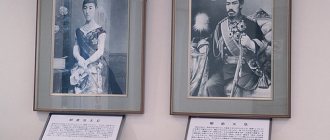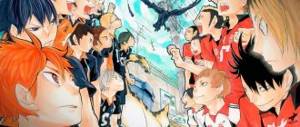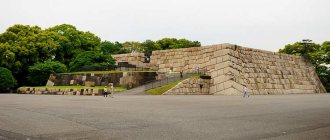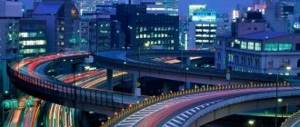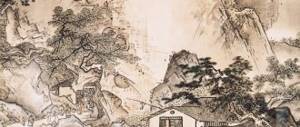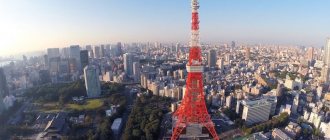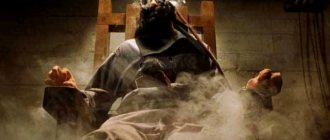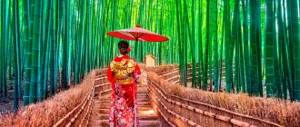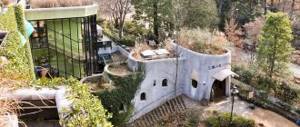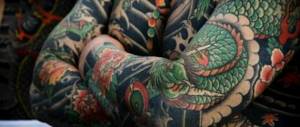The Tokyo Sky Tree is a 634-meter-tall (including antenna) television broadcast tower. From anywhere in the Japanese capital you can see its spire. Construction of the Tokyo Skytree lasted from 2008 to 2012 in Tokyo's Sumida district, near Asakusa. Among the tallest buildings in the world, it ranks second after the Burj Khalifa TV and Radio Tower in the Emirates. Two observation decks are open to visitors on the TV tower, from which you can enjoy the beauty of Tokyo.
Location and exact address
When traveling around Japan, you can easily get lost, especially in such a large metropolis as Tokyo. To find the location of Tokyo Sky Tree, tourists first of all get to the Sumida area by several means of transport:
- metro;
- bus.
The Tokyo Skytree landmark can be seen from afar, from almost any part of the capital, since the spire of the television tower is located at an altitude of 634 meters. You can get to Tokyo Sky Tree Town by visiting the address: Oshiage 1-1-13.
Attention! From Asakusa Station, you can cross the Sumida River in 20 minutes and end up at the famous Sky Tree.
TV and radio channels in Tokyo Skytree.
The most modern television tower broadcasts radio and television throughout Tokyo. Major TV channels such as NHK General TV, NHK Educational TV, Nippon Television, TV Asahi, Tokyo Broadcasting System Television, TV Tokyo and Fuji Television are located here.
In addition, Skytree broadcasts NHK Radio 1 Tokyo, NHK Radio 2 Tokyo and NHK FM. Previously, almost all of these channels were broadcast through the orange Tokyo Tower. The taller and more modern Skytree has a much wider range and can also broadcast the higher frequencies needed for digital television.
A few words about the town
The most populated part of the capital of Japan is the Sumida area. The name of this area is given after the Sumida River. This part of the city was formed in March 1947. According to census estimates, as of April 1, 2021, there are 266 thousand people living in Sumida.
The Sumida TV Tower opened in 2012 for tourists to visit. This area is rich in cultural life, and it is recommended to visit a couple of tourist spots, in addition to the radio communications tower.
For example, travelers will find it fascinating to look at the exhibits at the History Museum (Edo-Tokyo Museum). It is also recommended to visit the Tobu Railway Museum, Honjo Matsuzaka-Cho Park, and the Edo Period Flower Garden.
Lotte World Tower (554 m). Seoul, South Korea
0
Source:
Lotte World Tower is called the “Pearl of Korea”. The tower was named after its developer and owner, Lotte Group, as was the neighboring cultural and recreational complex. Both sites are important tourist destinations in Seoul. The light color palette of the glass curtain walls and soft curvature of the building are inspired by Korean ceramics and stand in stark contrast to the city. The building includes all the mixed-use spaces we've come to expect from supertall towers, such as offices, commercial space and a fashion hotel, but it also features a new type of function space unique to Korea: Officetel "office space." These are something like studio apartments that combine living and working space.
History and process of tower construction
The world's second tallest television tower was built to improve the transmission of digital TV signals to the upper floors of high-rise buildings and skyscrapers. In 2011, the Japanese government decided to transfer people to a new television format - digital. The radio communication tower turned out to be not as high as required, so it was decided to build it as soon as possible.
The builders raised the structure 10 meters into the air per week. Construction began in 2008. The TV tower was completed in 2012. On May 22nd there was an official opening. The opening was planned for 2011, but the event had to be postponed due to the earthquake.
Shanghai Tower (632 m). Shanghai, China
0
Source:
In second place on the list of the tallest buildings in the world is the Shanghai Tower. It also has the second-fastest elevators in the world and shares the title of the world's highest indoor observation deck with Ping An Financial Center. The architecture firm that worked on the building's design, Gensler, once called it "the greenest high-rise building on earth right now." Some of the green features that support this claim are sunshade systems, wind turbines, and geothermal energy sources.
"634" and other interesting facts
Tokyo Skytree has an extended structure at the base, so the attraction was built more than half a kilometer into the sky. To maintain proportions, the builders needed to build a base of 181 meters. But some difficulties arose due to lack of space. The site on which the structure was erected was first expanded by 8 meters. After this, a triangular base of the structure was erected, similar to a tree with its cone-shaped shape and a height of 634 meters.
Tokyo Skytree. Safety
About 1,500 earthquakes occur every year in Japan. Many of these earthquakes are too small in size, but some have caused significant damage.
Therefore, the Tokyo Skytree is attached to a frame that functions as a kind of hammock, moving with it to dampen ground vibrations. This makes Tokyo Skytree resilient enough to withstand severe earthquakes.
Architectural features
The design of the building was developed long before construction began. In 2006, the architects decided to build a teleradiocommunication structure in a neo-futuristic format. In addition, such a design had to be in harmony with Japanese traditions. It was also important to make the building durable: it should not collapse or be at risk during earthquakes.
Worth knowing! A special underground system under the tower compensates for up to 50% of underground vibrations during an earthquake.
CTF Financial Center (530 m). Guangzhou, China
0
Source:
Guangzhou Chow Tai Fook Financial Center serves the fast-growing metropolitan area of Guangzhou. The building is located on a platform (podium) of eight floors and is supported by eight mega columns. It is a perfect example of the "form follows function" concept. Because a building serves different functions, it requires different floor sizes. As a result, it simply acts as a "wrapper" around these areas and allows the requirements of each space to determine the form.
What to visit
On the first level you can go to a shopping center where there is an aquarium and shops. Tourists visit the television and radio tower for two attractions. They are located at 350 and 450 meters from the ground.
Tembo Deck
In terms of area, this attraction occupies 3 levels. At each level there is an amazing opportunity to contemplate the landscapes.
The third floor is lined with wide windows from ceiling to floor. From several vantage points the city is visible from all angles.
The second floor of the site is considered a recreation area: here you can visit the Japanese-French restaurant - Musashi Sky and shops with Japanese souvenirs.
At the lower level, durable inserts made of impenetrable glass are built into the floor. Through them you can see the foot of the TV tower.
Tembo Galleria Observation Deck
Two observation platforms are connected to each other. Through the Tembo Deck you can enter the Tembo Gallery. The second observation structure is 100 floors higher. Tembo Gallery is considered one of the tallest observation structures in the world. It looks like a spiral ramp, increasing as it winds up the tower. The tube-shaped structure with windows allows tourists to see the Kanto region in all its glory from a bird's eye view.
At the top of the ramp, you can relax on the high-rise platform - a spacious room with wide floor-to-ceiling windows.
According to official data, the Tembo Galleria floor of the Tokyo skytree tower is built at an altitude of 451.2 meters.
Tokyo TV Tower
Video: Tokyo Tower
Basic moments
Since 2012, the new television tower in Tokyo has taken over almost all digital television and radio broadcasting loads in and around the Japanese capital. In addition, it is used for mobile communications and navigation systems, and is also popular as a tourist attraction. The giant structure has become one of the hallmarks of Tokyo and a symbol of the technological achievements of Japanese society.
The reason for the construction of the new tower was Japan's transition to digital television. The old Tokyo TV Tower, which had been operating in the Japanese capital for half a century, could not cope with transmitting signals to the upper floors of some modern skyscrapers. In this regard, there was an urgent need to erect a much taller structure for modern television broadcasting.
Construction of a new television tower in the city began in the summer of 2008. The speed with which the Japanese got down to business amazed everyone. The steel structure “grew” by 10 meters per week! And by the end of February 2012, the new television tower was ready.
It should be said that according to the preliminary project, this construction was supposed to be completed in December 2011, but due to the earthquake that occurred in March 2011, funding was cut and the construction time was somewhat extended. Tokyo Tower officially opened on May 22, 2012. The costs for it turned out to be large-scale. 580 thousand specialists took part in the unusual construction, and $812 million was spent.
Recently, helicopter and bus tours around the Tokyo Skytree television tower have become very popular among travelers coming to Tokyo, allowing one to see the features of its architecture and design in great detail.
Old Tokyo TV Tower
Tokyo residents lovingly call their old TV tower “Tokyo Tawa”, slightly distorting the English words “Tokyo tower”. In the central part of the Japanese capital, it is visible from everywhere. The characteristic spire either rises above lower buildings or suddenly appears in the gaps of narrow streets. The old tower has a height of 332.6 m and externally copies the Eiffel Tower in Paris. However, it is 13 meters taller than its French prototype and 3 thousand tons lighter.
This TV tower appeared in the city in 1958. In accordance with existing international aviation safety standards, its metal structure is painted white and orange. Moreover, about 28 thousand tons of dyes are consumed for painting, which takes place once every five years. As a result of a strong earthquake in 2011, the upper part of the antenna of the old television tower was deformed.
Today, with the main television and radio broadcast via the Tokyo Skytree, the old Tokyo Tower is more of a tourist attraction. Every year, up to 2.5 million visitors visit its museums and two observation platforms located at an altitude of 150 m and 250 m. And over the years of operation, the old tower has already received more than 150 million guests.
The four-story building, called “Podnozhny Gorodok,” houses one of the best aquariums in the country, where more than 50 thousand fish are kept. There is a wax museum and a Guinness Book of Records museum, a permanent holography exhibition and a gallery of optical illusions. Under the old television tower there is a large restaurant, several cafeterias and souvenir shops. And on the roof of the Podnozhny Gorodok there are children's attractions.
The old TV tower is located at 4-2-8 Shiba-Koen, Minato-ku. Its observation decks are open from 9.00 to 21.30.
Design Features of the Tokyo Skytree or Heavenly Tree
Considering that Japan is located in a zone of increased seismic activity, all structures and buildings here are built so that they can withstand possible earthquakes. The new TV tower was no exception. During its construction, the most modern anti-seismic technologies were used. According to calculations, the Tokyo television tower will be able to withstand tremors with a magnitude of up to 7.0, even if the epicenter of the earthquake is located directly under the building itself. In case of danger, the structures developed by engineers will be able to absorb up to 50% of the energy of tremors. And this is a very large margin of safety!
The height of the new television tower in Tokyo is 634 m. This figure was not chosen by chance. In Japanese, the number combination 6-3-4 sounds like "mu-sa-si". "Musashi" is the name of the historical region within which modern Tokyo is located.
At its base, the Heavenly Tree presents a regular triangular structure. However, as the height increases, the shape of the television tower becomes more and more rounded. It has a completely circular cross-section at around 320 meters, so depending on the viewing angle, the tower structure looks different.
Sky Tree Tour
The name of the new television tower – “Tokyo Skytree” – was chosen by popular vote, which the city authorities held in the spring of 2008. 33 thousand Tokyo residents (30% of voting participants) voted for the tower to be named this way.
There are two observation decks available to visitors to the Tokyo Tower. The lower one is called “Tembo Deck”. It occupies three floors at altitudes from 340 m to 350 m. The high-speed elevator ride from the entrance to the tower to this observation deck takes only one minute. Through the wide, floor-to-ceiling windows, a panorama of the Tokyo city districts is clearly visible. Part of the floor here is made of transparent glass panels, and through them the foot of the giant television tower is clearly visible. On the lower observation deck there is a restaurant serving French-Japanese cuisine, a cafe and a souvenir shop.
The upper platform, which offers a truly breathtaking view of the city, is called “Skywalk” or “Heavenly Path”. It is located at an altitude of 445 meters and is connected to the lower observation deck by several elevators. At this level, you can take a circular ride on a spiral ramp around the Tokyo Tower, rising 75 m to a height of 451.2 m. This is the highest point of the Tokyo Skytree that visitors can reach.
At the foot of the television tower there is a large shopping and entertainment center with more than 300 shops, cafes, offices and restaurants. If desired, visitors can look into the aquarium, planetarium or postal museum located here. To get to the entrance to Tokyo Tower, you need to go up to the 4th floor of the shopping complex. For tourists, the TV tower is open daily from 8.00 to 22.00.
Features of purchasing tickets
At the entrance to Tokyo Tower, tickets are sold only for the lower observation deck. Tickets for the upper deck can be purchased by going up to the lower observation deck level.
When purchasing tickets directly on the day of visiting the tower, you may encounter a situation where there are many other people interested. In this case, the waiting time to enter the Tokyo Skytree Tower will be at least an hour. In addition, daily ticket sales are limited to 10 thousand pieces. This means that when there is an influx of visitors, the desired ticket may simply not be enough.
Tourists can buy tickets to the TV tower at a higher price - in the so-called “Skytree fast queue”. With special tickets you will not have to wait at the entrance. To the Tembo Deck observation deck, an adult ticket costs ¥2820, for teenagers 12-17 years old - ¥2260, for children 6-11 years old - 1580 ¥, children 4-5 years old - 1240 ¥, children under 3 years old can enter for free. Tickets without a pre-scheduled time are ¥500 cheaper. You can learn more about the rules for visiting the Tokyo Television Tower on the official website tokyo-skytree.jp/en.
How to get there
The new Tokyo Tower is located in the capital's Sumida Ward at 1-1-2, Oshiage, Sumida-ku. Tokyo Skytree can be reached on foot from Tokyo Skytree, Asakusa or Oshiage subway stations. From Tokyo Skytree Station it is easy to get to the tower by one of the buses that run along this route at intervals of 20 minutes and reach the tower in half an hour. From Tokyo Haneda Airport to the TV tower can be reached by bus in 50-70 minutes.
Shanghai World Financial Center (492 m). Shanghai, China
0
Source:
The Shanghai World Financial Center is a mixed-use skyscraper designed to make this area of Shanghai an important center for trade and culture. If you think all skyscrapers are just tall glass boxes, this building might prove you wrong. Two arcs intersect a square prism, creating the resulting building shape and the recognizable recess at the top of the building. This design symbolizes the meeting or crossing of heaven with earth to create balance. The designers were inspired by an ancient Chinese symbol. This building can show that there are many ways to incorporate relevant cultural meaning into even a super high-end piece of engineering.
My impressions of Gugun
While studying China, I, of course, wanted to get to Gugun. In my imagination, the Forbidden City was a fantastic place. But it so happened that I came here after visiting the luxurious gardens of Jiangnan (historical territories south of the Yangtze) and Beijing. And the result is huge disappointment at first. Instead of paradise and cozy pavilions, there are huge squares reminiscent of a parade ground, buildings that are overwhelming in their size, with a rather stingy, albeit bright, color scheme - purple, gold and gray.
I know that many of my non-Chinese friends were also somewhat disappointed with Gugong. Or rather, they expected to see something different. The impression is somewhat spoiled by the huge number of people: many foreigners come here from the most remote corners of China.
However, after learning the history of Gugun, getting acquainted with its main attractions and museum collections, my attitude changed. This palace is a must visit. It is here that you can truly feel the power of the Chinese empire, the greatness of its rulers, who bore the title Son of Heaven.
History of the Forbidden City
The Forbidden City was built from 1406 to 1420, when the third emperor of the Ming Dynasty (1368-1644) Zhu Di (朱棣, 1360-1424, on the throne since 1403; the motto of the reign was Yong-le 永乐, “Eternal Happiness”) ruled the Celestial Empire. It was Zhu Di who turned Beijing into the capital of China. All buildings are made of wood. Therefore, it is not surprising that the Forbidden City was burned and rebuilt several times.
According to legend, there are 9999.5 rooms in the Forbidden City. It is said that the emperor wished to have 10,000 rooms (“ten thousand”, 万 wan, is a significant number in Chinese culture). However, the angry Jade Lord appeared to him and declared that he had only ten thousand rooms in his palace in Heaven, so it was not appropriate for an earthly emperor, even the Son of Heaven (天子 tianzi, the title of Chinese emperors), to have the same number of rooms. Therefore, they made a little less - 9999 and another half of the room. In reality there are 8707 rooms.
The Forbidden City was built in strict accordance with the rules of Chinese geomancy - Feng Shui. The emperor was not only the ruler of a great country, but was also endowed with sacred status and priestly functions, mediating between Heaven and Earth, so every detail in Gugun has a certain meaning. The word "Purple" in the name refers to the North Star (Chinese: 北极星 beijixing), which was considered the abode of the Jade Lord. Just as all the stars in the sky make their course around the fixed Polar Star, so the emperor in the Forbidden City remains inactive and rules the Celestial Empire.
Entrance to the Forbidden City was limited to mere mortals. Foreigners were practically not allowed here. Therefore, naturally, the most fantastic legends were formed about what was behind the high walls of the palace.
Over a million workers and about 100 thousand different craftsmen took part in the construction of the Forbidden City. The rulers of the Qing dynasty (1644-1911) spent less time in Gugong than their predecessors, living most of the year in the Summer Palace (Yiheyuan) or Yuanmingyuan. In total, 24 emperors ruled the Celestial Empire for almost 500 years from behind the walls of the Forbidden City - 14 emperors of the Ming dynasty and 10 emperors of the Qing dynasty. After his abdication in 1912, the last Chinese Emperor Pu Yi (溥仪, 1906-1967, Chinese Emperor 1908-1912, retained the title until 1924) lived here until 1924.
Taipei 101 (508 m). Taipei, Taiwan
0
Source:
Taipei 101, formerly known as the Taipei Financial Center, is one of the most recognizable buildings on this list. It was also, for a time, the tallest building in the world until it was beaten by our reigning champion, the Burj Khalifa. While many skyscrapers are examples of modern design that could exist anywhere, there is something distinctly Asian about Taipei 101. The building consists of eight separate vertical parts, each of which occupies eight floors. This is due to the Chinese belief in the number eight's association with prosperity, wealth, abundance and good luck. Each group also features an abstract shape of a bamboo stalk, a pagoda, and Chinese ingots. The entire building also carefully considers Feng Shui philosophy in several design elements at different scales.
China Zun (528 m). Beijing, China
0
Source:
CITC Tower, often called China Zun, is the tallest building in Beijing. The name and design of China Zun are inspired by history: a zong is an ancient wine vessel that was used in rituals during the Bronze Age in China. This shape also serves an additional function: widening at the top and bottom and narrowing in the middle creates strong protection against seismic activity.
